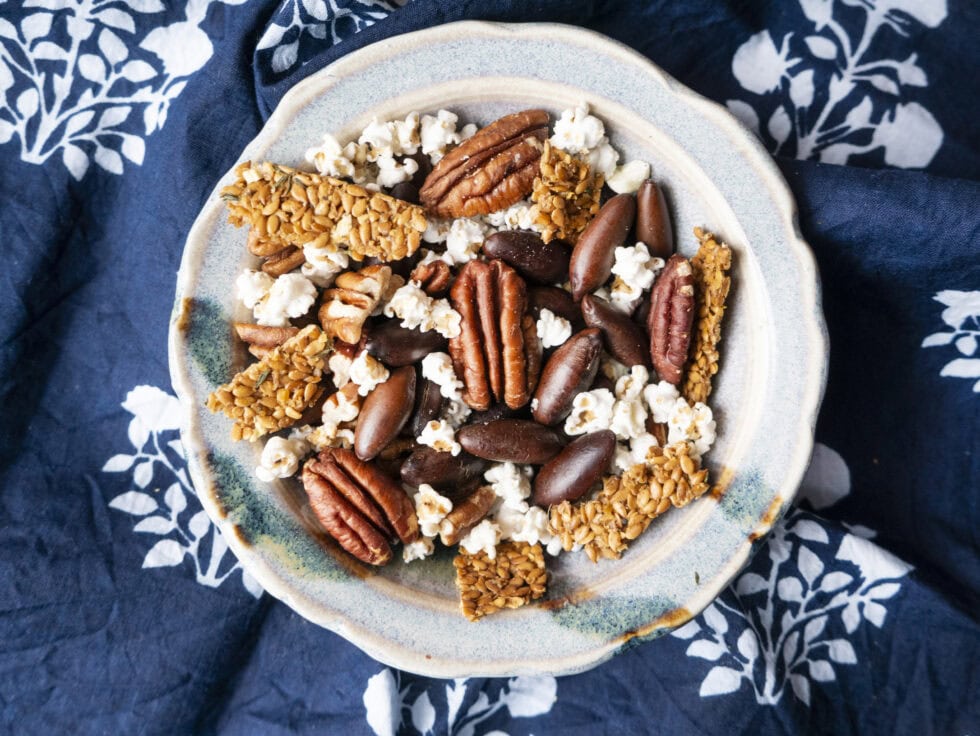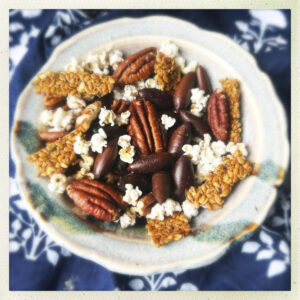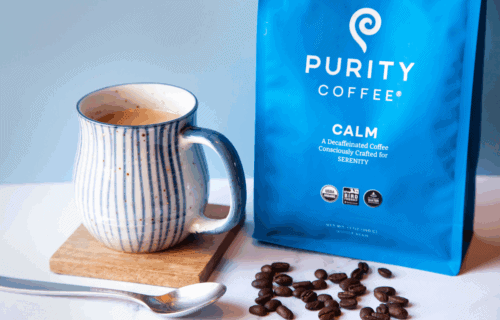
Low Histamine Snack Mix
We heard you wanted low histamine snacks! So, we made this easy, low histamine snack mix recipe.
This low histamine recipe can be made either savory or with a pop of sweetness.
We’ll share both ways with you.
The base ingredients are similar, but one uses a garlic and herb flax cracker and one uses cacao butter and monk fruit powder.
Why make your own snack mix?
You know exactly what you’re getting when you make snack mix yourself.
That means you can tailor the ingredients to meet your needs. You can’t do that with store-bought snack mixes, trail mixes, and granola.
If you have Histamine Intolerance, you’ll be able to avoid high histamine ingredients and histamine liberators like dried soybeans, sugary candies, peanuts, and cashews.
And if you have Lectin Intolerance, you’ll be able to bypass high lectin ingredients like rice (mini rice cakes or puffed rice) and oats.
You can also choose lower oxalate nuts and choose exactly how much you’ll use. Remember, with oxalates, the food itself matters. And so does the quantity.
This crispy, crunchy snack mix is easy to put together, especially if you choose the sweet option.
It’s perfect for snacking on the go!
This recipe is:
- Low histamine
- Low oxalate
- Low lectin
- Dairy free
- Gluten free
Keep reading to get the recipe and learn about some of the tasty main ingredients.
About the Ingredients in Low Histamine Snack Mix
Before you change your diet on your own, please make sure you’re working with a healthcare practitioner who can help you with this. Never limit foods unnecessarily, and always have a licensed medical provider who is supervising your case.
Eating high histamine foods adds to your histamine levels.
With Histamine Intolerance, it’s important to get those levels down to a point your body can handle.
Choosing low histamine foods instead of high histamine foods goes a long way to having a lower histamine load.
That’s why if you have histamine issues, a low histamine diet can be helpful.
Fortunately, you have a lot of options!
Let’s take a look at what you’ll use in this low histamine snack mix.
Nuts
Nuts are a great source of plant-based protein.
Protein provides the amino acids your body needs for many functions, including reducing inflammation.
This is important with Histamine Intolerance and Mast Cell Activation Syndrome (MCAS).
Both conditions can contribute to inflammation. And what’s worse is that inflammation can lead to more histamine release and mast cell activation!
Another benefit of protein is that it can help support your immune system.
Did you know that a lack of dietary protein or amino acids has been shown to impair immune function?
Remember, your mast cells are an important part of your immune system.
Protein rich, low histamine nuts that are also low lectin and low to medium oxalate include:
- Macadamia Nuts – (high oxalate if over 1/4 cup)
- Pecans – (high oxalate if over 1/4 cup)
- Pistachios – (high oxalate if over 1/4 cup)
In this recipe, we’ve used pecans. You can use a different nut, or a blend.
But if you’re thinking about adding a greater quantity of nuts, here’s the scoop on oxalates.
Oxalates and Nuts
Most nuts fall into the oxalate category.
Oxalates aren’t a problem for everyone.
If they aren’t a problem for you, you may also enjoy low histamine, high oxalate nuts like hazelnuts or almonds.
But here’s what to know if you do have Oxalate Intolerance.
The content of oxalate in the food itself is one way we determine if something is low or high oxalate.
The amount you eat also matters.
Macadamia nuts, pecans, and pistachios do have some oxalate content. This may be a problem in any amount for those who are very sensitive.
But if you have mild to moderate oxalate issues, you may do fine with under ¼ cup of these nuts.
This recipe calls for ½ cup of pecans total. And it makes 6 servings of ¼ cup each (that’s ¼ cup of all the ingredients combined).
That means that in each serving of this recipe, the pecans will be well within low oxalate range.
Next, let’s talk about the other nut in this recipe.
Baruka Nuts
Baruka nuts aren’t nuts at all!
They’re seeds from the Baruzeiro tree, native to South America.
Baruka nuts are sometimes also called baru nuts or even baru almonds.
The shape and color of baru nuts reminds us of a tiny football. Dark brown and elongated.
The taste and texture are similar to a peanut. And like the peanut, they have a thin papery outer layer that’s fine to eat.
Baruka nuts are low oxalate. This ingredient won’t alter the oxalate content of the recipe.
Benefits of baru nuts include:
- Rich in protein – supports immune system
- Good source of antioxidants – important for cell health
- Good source of fiber – good for gut health AND can help regulate mast cell function!
Baru nuts add a satisfying crunch to this low histamine snack mix.
But we’ve also used them for nut crusts in recipes like: Low FODMAP Salad & Dressing with Baru Nut Crusted Chicken
And we’ve used them in desserts like: Low Histamine Baruka Nut Vanilla Mousse
Next, let’s look at popped sorghum.
Popped Sorghum
Popped sorghum is the answer to your popcorn cravings.
It’s low histamine, low lectin, and low to medium oxalate, depending on quantity.
You’ve already read some about oxalates in the section on nuts.
Here’s how popped sorghum affects the oxalate levels of this recipe.
First, look at what’s considered low to very high oxalate per serving.
- Very high at 100 mg+
- High at 26 to 99 mg
- Moderate at 10 to 25 mg
- Low at 5 to 9 mg
Experts generally recommend keeping oxalates around 200mg per day or less to support the body without raising the risk of oxalate issues.
The oxalate content of unprocessed sorghum grains is around 30 mg oxalate/100 g ingredient.
We’ve used about 30 grams total of popped sorghum in this recipe.
So, we estimate that ¼ cup (30 grams) of popped sorghum in our recipe adds about 9 grams of oxalate per recipe. That’s considered low.
But remember, this recipe makes 6 servings of ¼ cup each (all the ingredients combined).
That means even with pecans, both ingredients in these quantities still don’t add enough oxalate content to bump this recipe up to medium oxalate.
Great news for those with Oxalate Intolerance!
Popped sorghum is a fun ingredient you can make yourself or purchase.
We used the pre-popped version to keep the recipe simpler.
But popping it yourself isn’t hard if you know a few tips. You can find those in our Low Lectin Sorghum Popcorn Recipe.
Should You Buy Premade or Pop Your Own?
In terms of store bought, Nature Nate’s offers a variety of popped sorghum.
Our favorite is the one made with organic ghee.
The only ingredients are organic sorghum, organic ghee, and Himalayan sea salt.
There’s another variety of the same brand made with avocado oil and sea salt.
Avocado is high histamine. But the oil is fine for most people with Histamine Intolerance.
While the ghee will be lower histamine overall, some people may do okay with the avocado one, too. It all depends on your histamine bucket. Go slow if it’s a new food for you!
These 2 choices from Nature Nate’s don’t have any flavor additives or preservatives.
And unlike some other brands, these choices aren’t popped in olive oil.
We love olive oil.
But the concern with olive oil here is that when it’s heated to high temperatures, it may contribute to inflammation. And inflammation leads to histamine release.
Presently, the thought is that olive oil’s smoke point isn’t as low as previously thought.
But it is lower than ghee or avocado oil.
And since we don’t know what temperature companies are using for popping the sorghum, we’re erring on the side of caution for those who are very sensitive.
If you’re in a later phase of the low histamine diet, store bought popped sorghum might be an option for you.
But if you are still in phase 1 and generally very sensitive, you probably want to steer clear of packaged foods for now.
Garlic and Herb Crackers
For many people, the garlic bread stick is the favorite piece of commercially prepared snack mixes like Chex Mix.
It looks just like a breadstick from an Italian restaurant. But it’s about half the size of your pinky finger, and it’s crunchy.
We wanted that same flavor bomb in our snack mix.
Like Italian Food? Check out the low histamine pesto recipe.
Remember, this low histamine snack mix recipe has 2 options, 1 savory and 1 sweet.
You’ll use the base ingredients of pecans, baru nuts, and popped sorghum for both.
If you choose to use the garlic herb crackers, that’s the savory option. This option requires some cooking time.
The prep time on the crackers is minimal.
And the cook time is only about 15 minutes, but that’s inactive time.
Making these garlic and herb flax-based crackers is the only cooking this recipe requires.
We used flax seed, both whole and ground.
And we used garlic, thyme, and oregano.
You can use whatever herbs you like, though.
And you can add more garlic if you really want a punch of flavor.
Once baked, you’ll break up the crackers and add them to your snack mix.
TIP: Double or triple the cracker part of the recipe to have extra crackers on hand for snacking anytime.
Don’t feel like cooking? Have a sweet tooth? Then, go with the sweet option.
The sweet option requires no cooking. Only mixing. It’s tasty and takes under five minutes to put together. Super easy!
Again, please note that if you choose garlic crackers, you’ll skip adding the cacao butter and monk fruit powder which make up the sweet option.
Speaking of the sweet option, let’s look at cacao butter next.
Cacao Butter
Some snack mixes have a sweet and salty combo.
In most snack mixes the sweet might come from candy like M&M’s or fruit like dried apples.
Candy definitely has sugar. And some dried fruit has added sugar.
Both white sugar and brown sugar can spike blood sugar levels, causing histamine release.
And dried fruits can have preservatives like sulfites.
The most common food additives people don’t tolerate are:
- Sulfite
- Sodium benzoate
- Food coloring
Not everyone has a sulfite allergy, sensitivity, or intolerance. But it isn’t uncommon in our practice to see someone with Histamine Intolerance or Mast Cell Activation Syndrome who has other sensitivities, too.
That’s why in phase 1 of the low histamine diet, we suggest avoiding common food triggers like corn, dairy, and additives and preservatives.
Plus, dry fruit has higher histamine levels than fresh or frozen. And it’s more prone to have mold.
For our “candy”, we used chopped organic cacao butter with a sprinkle of monk fruit powder to give this recipe the creamy, sweet feeling of white chocolate.
Cacao butter is a plant-based fat that comes from the cacao bean.
You might associate cacao with chocolate.
It’s true that chocolate comes from cacao. And cacao butter is used to make chocolate candies.
But cacao butter is extracted from the bean in a different process than chocolate.
So, even though the name suggests it should have chocolate and dairy, it has neither!
And cacao butter is low histamine, whereas chocolate can act as a histamine liberator.
When choosing cacao butter, choose a product with 1 ingredient only: organic cacao butter.
This low histamine snack mix packs up easily for snacking on your work break or a road trip.
Enjoy!
Party Nibbles to Serve with Low Histamine Snack Mix
- Roasted Garlic Cauliflower Hummus Recipe – Low Oxalate, Low Lectin
- Candied Ginger Pecans Recipe – Medium Oxalate, Low Lectin, Low FODMAP
- Mango Salsa – Low Oxalate, Low Lectin Option
- Apple Salsa 2 Ways – Low Lectin, Low Oxalate

Low Histamine Snack Mix
Equipment
- Sharp Knife
- Silicone Mat OR
- Popcorn Popper optional (for sorghum)
Ingredients
Ingredients for Snack Mix
- ½ cup Baruka (Baru) Nuts
- ½ cup Pecans
- ¼ cup Popping Sorghum popped OR
- ¼ cup Nature Nate's Popped Sorghum
- ¼ cup Bite Sized Garlic Flax Crackers (for savory option)(ingredients listed below)
Savory Option – Garlic Flax Cracker Ingredients
- ¼ cup Flax Seeds whole
- 1 Tablespoon Flax Seeds ground
- ⅛ cup Filtered Water warm
- 2 Garlic Cloves
- ½ teaspoon Fresh Organic Thyme chopped
- 1 teaspoon Fresh Organic Oregano chopped
- ⅛ teaspoon Redmond Real Salt
Sweet Option – Omit Crackers and Add
- ¼ cup Organic Cacao Butter chopped into bite sized pieces
- 1/32 teaspoon Smart Monk 100% Pure Monk Fruit Powder use with Cacao Butter Option Only
Instructions
Savory Option – Start Here
- Savory – If you are making garlic crackers, start here. If you are using the cacao butter option, skip to section below for 'Sweet Option'.
- Preheat the oven to 350° F.
- Line a baking sheet with parchment paper.
- In a small blender, pulverize ⅛ cup of the flax seeds into a fine meal if you haven’t done so already.
- In a medium bowl, combine the ½ cup of whole flax seeds with the ⅛ cup of ground flax seeds with the warm water. Stir thoroughly to combine. Set aside.
- While the mixture thickens, mince the garlic and chop up the thyme and oregano. Add to the flax mixture along with the salt and stir thoroughly. Set aside a few more minutes until mixture is thick enough to hold together.
- Spread the mixture on a baking sheet lined with a silicone mat or parchment paper. With your hands, loosely form the mixture into a rectangle. Then cover with another piece of parchment paper and press or roll the mixture out until very thin and even. About 3 mm thick. Remove the top sheet of parchment.
- Bake the crackers for 16 minutes or until crispy.
- While the crackers bake, combine the baruka nuts, pecans, and popped sorghum into a bowl. Set aside.
- When crackers are done, cool slightly and then break into bite sized pieces.
- Combine the cracker bites with baruka nuts, pecans, popped sorghum in a bowl and enjoy!
Sweet Option – Start Here
- Sweet – If using cacao option, start here. Cut cacao butter into small pieces. Sprinkle with 1/32 teaspoon of monk fruit powder.
- Add cacao nibs to baruka nuts, pecans, and popped sorghum in a medium bowl and mix. Enjoy!
Notes
- Nutritional Information reflects the garlic flax cracker option.
- This recipe is low oxalate at 1 serving of ¼ cup.
Nutrition
Did you enjoy this low histamine snack mix recipe? What ingredients will you add to personalize your mix?
More Low Histamine Snack Ideas
- Blueberry Cassava Flour Muffins – Medium Oxalate, Low Lectin, with Low Salicylate Option
- Fruit Apple Pie Smoothie Recipe – Low Oxalate, Low Lectin
- Dip with Roasted Garlic and Pecans – Low Oxalate, Low Lectin
The website provides approximate nutrition information. Users should calculate the nutritional information with the actual ingredients and quantities they use in their recipes for the most accurate representation.
Some links in this website are affiliate links, which means Mast Cell 360 may make a very small commission if you purchase through the link. It never costs you any more to purchase through the links, and we try to find the best deals we can. We only recommend products that we love and use personally or use in the Mast Cell 360 practice. Any commissions help support the newsletter, website, and ongoing research so Mast Cell 360 can continue to offer you free tips, recipes, and info. Thank you for your support!
References
Alves-Santos, A. M., Fernandes, D. C., & Naves, M. M. V. (2021). Baru (Dipteryx alata Vog.) fruit as an option of nut and pulp with advantageous nutritional and functional properties: A comprehensive review. NFS Journal, 24, 26–36. https://doi.org/10.1016/j.nfs.2021.07.001
Aquilani, R., et al. (2021). Essential amino acid supplementation is associated with reduced serum C-reactive protein levels and improved circulating lymphocytes in post-acute inflamed elderly patients. International Journal of Immunopathology and Pharmacology, 35, 20587384211036823. https://doi.org/10.1177/20587384211036823
Create & Generate nutrition Labels | RecIPal. (n.d.). https://www.recipal.com/
D’Alessandro, C., et al. (2019). Which diet for calcium stone patients: a real-world approach to preventive care. Nutrients, 11(5), 1182. https://doi.org/10.3390/nu11051182
Folkerts, J., et al. (2018). Effect of dietary fiber and metabolites on mast cell activation and mast cell-associated diseases. Frontiers in Immunology, 9, 1067. https://doi.org/10.3389/fimmu.2018.01067
Li, P., et al. (2007). Amino acids and immune function. The British journal of nutrition, 98(2), 237–252. https://doi.org/10.1017/S000711450769936X
MyPlate.gov | Protein Foods Group – one of the five food groups. (n.d.). https://www.myplate.gov/eat-healthy/protein-foods#:~:text=Proteins
Worm, M. (2011). Q&A: Food additive intolerance. BMC Medicine, 9(1). https://doi.org/10.1186/1741-7015-9-115




Add A Comment